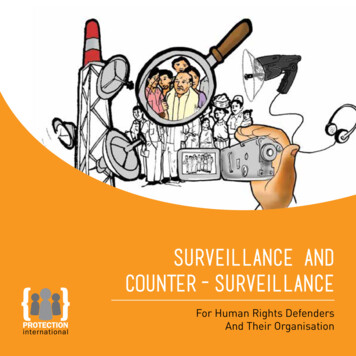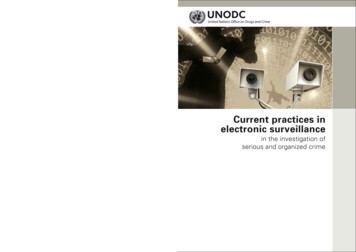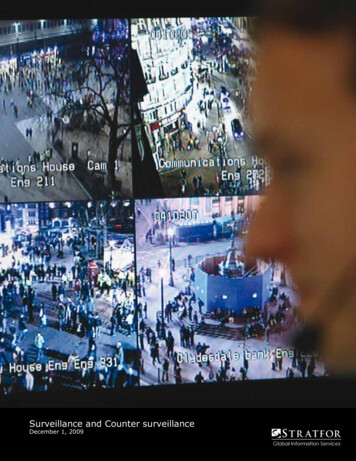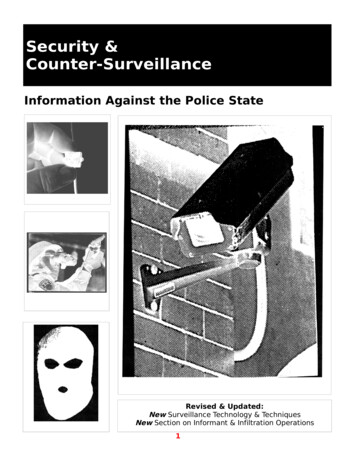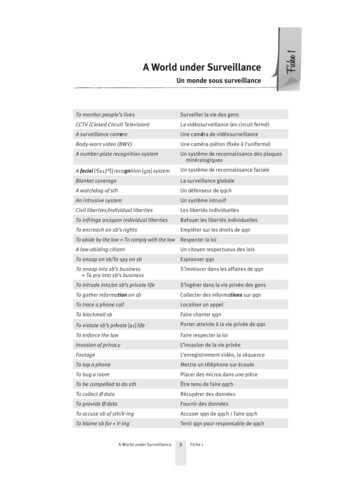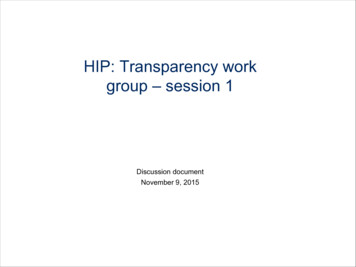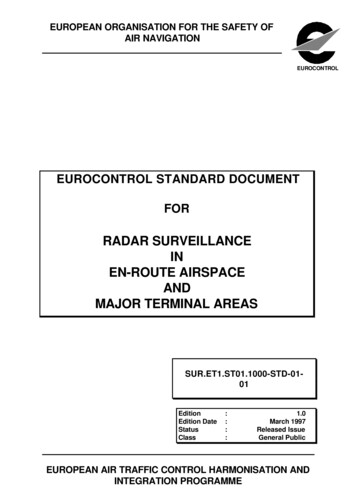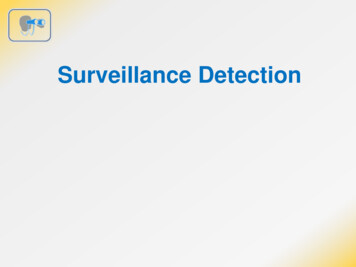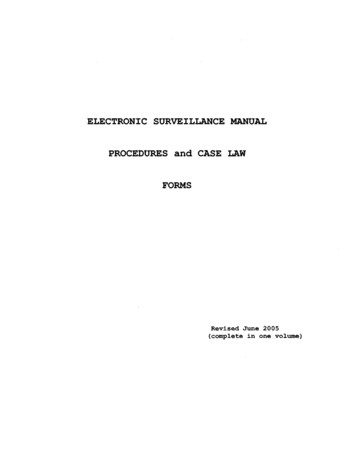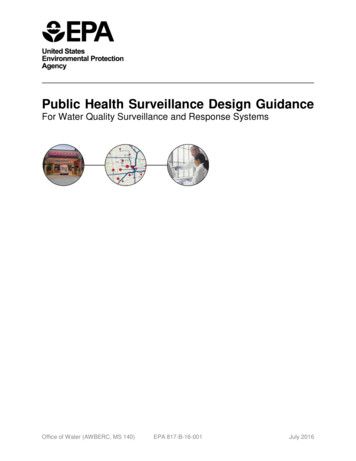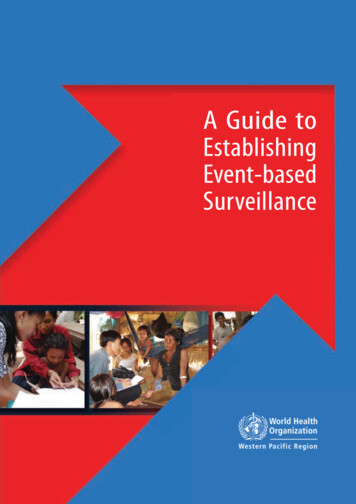
Transcription
Veillance and Reciprocal Transparency:Surveillance versus Sousveillance, AR Glass,Lifeglogging, and Wearable ComputingSteve MannSurvVeillanCeNTRETM , 330 Dundas Street West, Toronto, Ontario, Canada, M5T 1G5Abstract—This paper explores the interplay between surveillance cameras (cameras affixed to large-entities such as buildings)and sousveillance cameras (cameras affixed to small entitiessuch as individual people), laying contextual groundwork for thesocial implications of Augmented/Augmediated Reality, DigitalEye Glass, and the wearable camera as a vision and visualmemory aid in everyday life.We now live in a society in which we have both “the fewwatching the many” (surveillance), AND “the many watchingthe few” (sousveillance). Widespread sousveillance will causea transition from our one-sided surveillance society back to asituation akin to olden times when the sheriff could see whateveryone was doing AND everyone could see what the sheriff wasdoing. We name this neutral form of watching “veillance” — fromthe French word “veiller” which means “to watch”. Veillance isa broad concept that includes both surveillance (oversight) andsousveillance (undersight), as well as dataveillance, uberveillance,etc.It follows that: (1) sousveillance (undersight) is necessaryto a healthy, fair, and balanced society whenever surveillance(oversight) is already being used; and (2) sousveillance has numerous moral, ethical, socioeconomic, humanistic/humanitarian,and practical justifications that will guarantee its widespreadadoption, despite opposing sociopolitical forces.Fig. 1.Many business establishments prohibit cameras, e.g.: “NOCELL PHONES”; “NO CAMERAS”; “NO CELL PHONE IN STOREPLEASE!”; and “No video or photo taking”, while at the same timerequiring customers to bring and use cameras in order to read QR codesfor pre-purchase product information. And while forbidding customers fromhaving or using cameras, these establishments are installing their own camerasto keep their customers under surveillance, creating a one-sided form of“veillance”. Surveillance often embodies this hypocrisy — watching whileforbidding others from watching. The opposite (inverse) of hypocrisy isintegrity. Is there a veillance that is the opposite of surveillance — a veillancethat embodies integrity rather than hypocrisy? In this paper, we explore“sousveillance” (the opposite of surveillance) as a possible answer to thatquestion.I. W EARABLE C OMPUTING AND AUGMEDIATED R EALITYThis paper addresses some of the “Technology and Society”issues [1], [2] related to wearable computing, AR (Augmentedor Augmediated1 Reality), the personal seeing aid (DigitalEye Glass), the VMP (visual memory prosthetic) [4], [5], andissues of transparency [6].These issues are not only of interest to academics. Theissues are also of practical, commercial, and industrial significance now that wearable camera products are being massproduced, sold, and widely used in everyday life. MoreoverWearable Computing and AR has grown to a 200 billion industry at a time when more and more business establishmentsand similar places are installing surveillance cameras yet atthe same time are prohibiting individuals from using theirown cameras. See Fig 1. These “no camera” policies adverselyFig. 2. Examples of the author’s Digital Eye Glass and wearable computing [9] inventions used in everyday life over a more than 30-year time period.Digital Eye Glass causes the eye itself to, in effect, become both a camera anddisplay [10], by way of the “Glass Eye Effect” [11] as originally developedin the MannGlasTM computerized Augmediated Reality welding glass.affect those who use wearable cameras for AR, wayfinding,etc., as well as such systems as described memories for thevisually impaired (e.g. recording one’s life in order to get afterthe-fact assistance or advice at the end of each day [7]), ortransmitting live video for remote assistance with sight (e.g.the “Seeing-eye-People project [8]).Wearable cameras and AR, when used in everyday life (seeFig 2) give rise to a new kind of “veillance” (watching) thatis broader in scope than surveillance. To truly understand thisnew kind of veillance, and its surrounding social and intel-1 “Augmediated” is a portmanteau of “augmented” and “mediated”. Itrefers to an ability not merely to add overlays (augment) but also tosubtract (e.g. deliberately diminish) or modify reality. Examples include theMannGlassTM /CYBORGlassTM helmet fitted with a single piece of 4.5 by 5.25Digital Welding Glass, through which both “EyeTapped” eyes look to see a diminished reality of the bright light of the arc and simultaneously an augmentedreality of the darker areas of the scene, together with computerized overlays toannotate a workpiece being welded. [3] Specifically, an Augmediated Realitydevice has 3 elements: image sensing; image processing; and image displaycapabilities (i.e. it is a “wearcam”, “wearcomp” and “weardisp”).c978-1-4799-0929-2/13/ 31.00 2013IEEE1
lectual landscape, we first need to understand surveillance,which traditionally has been the more studied, applied, andwell-known veillance.II. S URVEILLANCESurveillance has recently emerged as a large commercialindustry, sized at 22 billion in 2012 and estimated to grow to 26 billion in 2013, at an annual growth rate of 20.4% [12].There are approximately 30 million commercial surveillancecameras in the United States, recording billions of hoursweekly (Popular Mechanics magazine). Police and governments around the world are installing surveillance camerasthroughout entire cities. Computer vision is also being used tobring video surveillance cameras into essential life and safetydevices like automatic fire detection [13] (camera-based smokedetectors [14]), motion-detectors [14], and occupancy sensorsfor use in “classrooms, in private offices, and restrooms”[15]. These camera-based occupancy sensors “determine thenumber and positions of the occupants” for increased energysavings [16].Just like there is a camera in most cellphones,soon there will be a camera in most light fixtures,including streetlights, for both occupancy sensing (seehttp://www.lsgc.com/pixelview/) and security(see http://intellistreets.com/):“THOUSANDS of old-fashioned street lights inMerseyside are set to be dismantled and replacedwith hi-tech CCTV-equipped lamps. The 32.7mscheme would see about 14,000 lampposts acrossKnowsley modernised .” —- Nick Coligan, Liverpool Echo, Nov 29 2007Total surveillance has crept into most facets of our lives,including surveillance cameras in washrooms, changerooms,and locker rooms. A CBC news headline informs thatAlberta’s Privacy Commissioner is in favour of locker-roomsurveillance cameras: “Cameras can stay in Talisman’s[athletic centre] locker room, says commissioner” 007/03/22/talisman-privacy.html).And modern automatic flush toilets, faucets, and sensoroperated showers are starting to use more sophisticatedcamera-based computer-vision technologies (e.g. U.S. Patent5828793).A. Surveillance studiesSurveillance has also emerged as a field of study[17], [18]. For example, a “Surveillance Studies Centre”was created at Queen’s University with a 2.5 milliongrant [19]. (see n-from-sshrc)Numerous conferences and symposia are now dedicated tothe topic of surveillance. For example, the IEEE, one of manydifferent technical societies, offers the following surveillancerelated conferences, symposia, and workshops each year: IEEE International Conference on Advanced Video andSignal-Based Surveillance (AVSS); IEEE International Symposium on Monitoring & Surveillance Research (ISMSR);2Fig. 3. The Transportation Security Administration (TSA) funds variousstudies and research into new surveillance technologies such as cameras andscanners that operate at higher frequencies of electromagnetic radiation thanthe visible light spectrum, in order to detect weapons by seeing throughclothes. (public domain images obtained from Wikimedia Commons) Although the images in this early example are of poor quality, the technology issteadily being improved, and subsequent see-through-clothing camera modelsoperate at much higher resolution. Some full-body scanners now provideenough detail to recognize and positively identify individuals [22].IEEE International Workshop on Socially IntelligentSurveillance and Monitoring (SISM); IEEE Workshop on Visual Surveillance; IEEE International Workshop on Performance Evaluationof Tracking and Surveillance,and there are numerous other surveillance conferences, symposia, workshops, and the like. B. TerrorismMuch of the practice, industry, and study of surveillancefocuses on terrorism. For example, the US Department ofHomeland Security, which was formed in response to theSeptember 11 terrorist attacks [20], and the Transportation Security Administration (TSA), have funded studiesand research on developing new technologies for surveillance, such as cameras and imaging systems that can seethrough clothing. [20] [21] See Fig 3. While promises havebeen made that these systems don’t record images, it hasbeen found that they often do record images, and recording capability was among the requirements of the TSA(http://epic.org/open gov/foia/TSA Procurement Specs.pdf).In some ways this parallels how every student was requiredto pose nude for pictures at certain Ivy League universities,so researchers could evaluate their physiques [23], [24]. Studies compared physical body shapes of Ivy League studentswith body shapes of prisoners, to understand the relationshipbetween physique and the likelihood a person would commit2013 IEEE International Symposium on Technology and Society (ISTAS)
sur-veil-lance [ser-vey-luh ns] noun1) “a watch kept over a person, group, etc., especially over a suspect, prisoner, or the like: Thesuspects were under police surveillance.” [25]Fig. 4. France, approximately 200 years ago when and where the words“terrorism” and “surveillance” were first coined at the Reign of Terror[27], and Today, where surveillance cameras overlook residential streets (andpeople’s private balconies). Images from Wikimedia Commons.crime-in-general [23], [24], although the focus was not specifically on contraband or terrorism.Terrorism, in the modern sense, is defined as by MerriamWebster, Dictionary.com and Wikipedia as:ter·ror·ism /’ter ,riz m/ noun “The use of violence andintimidation in the pursuit of political aims.”eeThe modern use of this word differs somewhat from theoriginal use of the word. The words “surveillance” and “terrorism” both originated in the late 1700s and early 1800s fromthe “Terror in France” [25]. During this “Reign of Terror”,41,594 people were executed, many merely for their politicalviews or associations [26]. See Fig 4.The word “Terrorism” comes from the French word “terrorisme”, referring specifically to state-terrorism in the form ofviolence practiced by the French government against its ownpeople [28] [29] [30]. This “terrorism” was used as a “weaponfor political repression in a time of . civil upheaval” duringthe “Reign of Terror” (“la Terreur”) [28] [29].The CoPS (Committee of Public Safety, French Comitéde salut public), created by the French leglislative assemblyin 1793, was the first “terrorist organization”. Its agentsenforced the policies of the government’s “Reign of Terror”and the government employees of the CoPS were referred toas “Terrorists”. [28] [29] [26]The word “terrorism” entered the English language byway of the London Times in January 30, 1795, and wasfirst recorded in English-language dictionaries in the 1790sas meaning “systematic use of terror as a policy”, by agovernment against its own people, to, for example, suppresscivil unrest. [28] [29] [26] [30] This original usage of theword is somewhat different from its modern meaning thatincludes acts perpetrated by individuals or by non-governmentorganizations.C. Etymology and origin of the word “surveillance”The primary definition of the word “surveillance” is:The etymology of this word is from the French word“surveiller” which means “to watch over”. Specifically, theword “surveillance” is formed from two parts: (1) the Frenchprefix “sur” which means “over” or “from above”, and (2)the French verb “veiller” which means “to watch”. The closest pure-English word is the word “oversight” [31], whichemerged around the year 1300, and, in current English usage,has a similar, though broader and slightly different meaningthan “surveillance”. “Oversight” can mean: (1) “an omissionor error due to carelessness. My bank statement is full of oversights.” or (2) “supervision; watchful care: a person responsible for the oversight of the organization.” Google Translatereturns the french word “surveillance” when presented withthe English word “oversight”.See Table 1. In particular, note the difference betweenveillance and surveillance.EnglishFrenchto seevoirto look (at)regarderto watchveillerwatching (monitoring)veillancewatching over (oversight)surveillanceto oversee (to watch from above)surveillerover (from above)surunder (from below)sous“undersight” (to watch from below) sousveillanceTable 1: Some English words and their French counterparts.III. S OUSVEILLANCEA more recently coined word is the word “sousveillance”,which is an etymologically correct opposite formed by replacing the prefix “sur”, (which means “over”, as in “surtitles” or “surcharge”) in “surveillance”, with its opposite,“sous” [32]–[35], which means “below,” “beneath,” or “under,”(as in “sous-chef”). See last 3 entries of Table 1.A. Hierarchical sur/sousveillanceA literal interpretation of veillance (sur and sous) gives riseto the simple definitions [36] that embody a twentieth-century“us versus them” dichotomy: Surveillance: Observation or recording by an entity ina position of power or authority over the subject of theveillance. Examples: Police observing or recording theactivities of citizens; shopkeepers watching over shoppers; a taxicab driver recording activities of passengersin the taxi; Sousveillance: Observation or recording by an entity notin a position of power or authority over the subject ofthe veillance. Examples: Citizens observing or recordingactivities from their own perspective, which includes therecording of the activities of police in the area (as well2013 IEEE International Symposium on Technology and Society (ISTAS)3
makes the criminal activity more lucrative, which may causemore Upward inhabitants to consider criminal activity.Fig. 5. Placing some members of society (e.g. those in the East End oftown) under surveillance merely “pushes” crime elsewhere in the society.as fellow citizens); Shoppers recording the activities in ashop (including those of the shopkeeper), etc.These definitions address power relationships of the involvedparties, as distinct from other sociological frameworks suchas ANT (actor-network theory) [37]. Sousveillance is notanti-surveillance or counter-surveillance! A person can, forexample, be in favour of both veillances, or opposed to both,or can favour one and not the other.B. The Ladder Theory of Veillance and the Fruit AnalogyIn a heirarchical civilization, people exist on different“rungs” of a sociopolitical or socioeconomic “ladder”, fromthe chimney sweep at the “bottommost rung”, to middle classshoppers, to the security guards and police, to the policechiefs, to the mayor, all the way up to congressional oversightcommittees, and the like.In a surveillance society, security guards and police watchover the citizens, the police chief watches the police, andperhaps an oversight committee watches over the police chief.This raises the important questions:1) “Who watches the watchers?”;2) “Who watches the watchers of the watchers?”;3) “Who watches the watchers of the watchers of the watchers?”;and so on ., to which an obvious answer is the democratic processof citizen “undersight” — the “swollag [7]” of democracy itself!In many modern cities, surveillance cameras are firstinstalled in some areas of the city, which is said to“push crime” elsewhere. See Fig 5. Surveillance cameras do provide “situational crime prevention” [38], [39](http://www.popcenter.org/), which contribute to some prevention and deterrence of crime, but other crimes merely movein response to the cameras.Putting surveillance cameras throughout all areas of thecity at “street-level”, e.g. throughout shopping malls, underground parking garages, and city streets, does not completelyextinguish crime. While it hinders low-level street crimes,surveillance may still allow, and in fact can actually cause,higher-level crimes, as follows: Street thugs may be caught andsent to jail, or otherwise slowed down, causing a shift in themarket equilibrium. For example, the increased effectivenessof security guards and law enforcement officials may create avacuum in the marketplace for stolen goods. The demand forstolen goods remains, but the reduced supply can drive up theprice of the stolen goods. This increased price of stolen goods4C. Does surveillance turn pickpockets into politicians? . TheFruit AnalogyWe don’t expect an uneducated “pickpocket” street criminalto suddently become a politician because of surveillance. Morelikely many such “pickpockets” and other street criminals willsimply be arrested and imprisoned, and low-level crime will bereduced — opportunities in lower places will be extinguishedor diminished by surveillance, while new opportunties inhigher places will remain or even grow (examples wheresurveillance actually causes crimes).The kinds of crimes caused or facilitated by surveillancerequire some degree of sophistication, cleverness, intelligence,or “specialized access” [40]–[42] to perpetrate, and are thusnot the same types of crime perpetrated by less-educated streetcriminals. Specialized access often requires specialized skills.Whereas much of the East-West migration of criminals illustrated by example in Fig 5 occurs through actual movementof criminals, the upward crime-shift occurs mostly through aform of “motion without movement” [43], analogous to the“light chasers” used on theatre marquees where motion (without movement) is generated by extinguishing a light source inone place while illuminating a light source elsewhere.This upward crime-shift can be understood by way of the“Fruit Analogy”. The Low-Hanging-Fruits (LHF) of crime areremoved at street-level, driving up the price in stolen “fruit”,thus creating new opportunities for crime in higher places,or insider-trading in stolen “fruit”. And, since “ladders” areneeded to reach the higher-hanging fruits, there exists: (1) anincreased incentive for thieves to climb such ladders; (2) anincreased incentive for those already further up these laddersto consider the possibility of stealing these higher fruits; and(3) the possibility of using the ladder itself as a tool for crime.This third new possibility of using (or temptation to use)the surveillance cameras themselves for criminal purposes(e.g. security professionals or police stalking potential victims)could be more tempting to certain members of the securityforces. For example:“A SECURITY guard at one of Edinburgh’s best-knownvisitor attractions used CCTV cameras to stalk a youngfemale worker and spy on the public.James Tuff used the camera system at Our Dynamic Earth,Edinburgh, to track his victim and then radio her with lewdcomments.He even trained the cameras on members of the publicmilling about outside, in one case saving footage of twogirls kissing to show to colleagues.Tuff eventually sexually assaulted Dora Alves . He wasfined and placed on the sex offenders register for threeyears. . She said: “At first it was just the odd commentabout my body; he would say things about me having areal woman’s body . But soon after he would appear outof nowhere when I was cleaning in the toilets. .” as shewalked to the canteen on her break and stopped to collectsomething from her locker. “Mr Tuff came out of his office2013 IEEE International Symposium on Technology and Society (ISTAS)
and grabbed me from behind. .” She said CCTV footagewhich could have proved the incident took place had gonemissing.” [44]Thousands of other examples — too numerous to enumeratehere — have appeared in recent media, and the phenomenaof surveillance-induced corruption is well-documented in thescholarly literature [45]–[47].These cases raise two interesting issues: (1) the conflict-ofinterest inherent in surveillance (e.g. CCTV footage mysteriously disappearing when under the control of authorities);and (2) the fact that the surveillance equipment facilitatesor helps in the perpetration of many crimes, as well as thecoverup (1) above. This is not to suggest that all securityguards, police, politicians, priests, etc., are corrupt — most ofthem are good people. But they — apart from the screeningand filtering process they undergo to enter their positions ofpower — are just like the rest of us — mere humans whoare subject to the same temptations and character flaws thatall of us have. For example, Roman Catholic priests have —despite the various checks and balances (screening and filteringprocesses, etc.) — used their high positions of power and theiraccess to impressionable children to perpetrate crimes such aschild abuse — while using their respected positions and churchhierarchy to stifle scrutiny [48].Moreover, the screening and filtering process for thosein positions of authority is itself undermined in situationswhere there is a shortage of police. “In the MetropolitanPolice, a shortage of applicants made it unnecessary to applysophisticated selection techniques.” [49].Thus there is no reason to assume that those in high places(e.g. priests, politicians, police, etc.) are flawless and shouldthus be able to watch over us without us being able to watchback! Otherwise, the one-sided nature of surveillance allowsit to, under certain circumstances, become the very “ladder”that facilitates this high-level corruption. See Fig 6.D. Sousveillance (undersight) as a possible remedyIn the context of the Ladder Theory, surveillance can leadto corruption, and absolute surveillance can lead to absolutecorruption. Simply having oversight committees to overseeother oversight committees could result in an endless spiralof upwardly-mobile corruption. In this situation, sousveillancecould function as a possible remedy to balance the otherwiseone-sided nature of surveillance.E. Sousveillance to bring positive actions to lightSousveillance is not only about bringing wrongdoing tolight. There are numerous examples of candid citizen sousveillance being used to catch police doing acts of good: m); the heroic actions of Seargeant Mark Colombo of theBoston Police Department, against a drug-crazed carthief, http://www.youtube.com/watch?v -SJakYMWnnY the kindness of New York Police Officer Larry DePrimo,who noticed a[n apparently] homeless man without shoeson a cold winter night. The officer bought shoes forFig. 6. Children’s drawing (redrawn by artist M. Zandwyk) makes an oversimplification that is nevertheless illustrative. It suggests that surveillanceeverywhere down at street level “pushes” crime up the “rungs” of thesocial ladder — so that it rises above the purview of the downward gazeof the cameras that watch from above. In reality, surveillance is unlikelyto cause an uneducated street criminal to rise to a position of power, theupward-shift in crime occurs instead due to shifts in market equilibrium [45]–[47] and other sociopolitical factors. Despite checks and balances, oversightwithout undersight can cause high-level political corruption that gives rise toan “upward” shift in crime, elevating low-level street crime to higher-levelcorruption. Ironically, the thief’s ladder is clearly visible to the surveillancecameras — as if to suggest that those in high places might be aware of —and continue to allow — crime and corruption that benefits them. Indeed,some criminals carry some of their proceeds “up” the “ladder” in the form ofbribes, and the like [50].the man, with money out of his own pocket, and, unbeknownst to the officer, the incident was photographedby a passing tourist. The picture was sent to NYPDheadquarters and posted on Facebook.com and got morethan 500,000 likes and 39,000 comments [51].These examples show how sousveillance and citizen undersight through social media can capture incidents — whethergood or bad — and serve as a potentially less-biased and moreneutral feedback mechanism than police-owned surveillanceonly media.F. Participatory veillanceIn the past, the word “surveillance” primarily meant “thefew watching the many”, as for example, described by MichelFoucault in his writings about Jeremy Bentham’s Panopticon [52]. Until recently surveillance was done by humanobservation: those “on top” watching those below, with theirown eyes. But today, surveillance more commonly involvessurveillance cameras, and in particular, a more modern definition of surveillance is the recording or observing of an activityby a non-participant in the activity [32], [34]–[36], [53].Surveillance is the observation or recording of an activityby a person not participating in the activity. [32], [36],[53]2013 IEEE International Symposium on Technology and Society (ISTAS)5
s, lanceS, "X"ceC1nllaei sP1cVM S s0Anti Sousveillancece SS sTotal veillance1Anti SurveillanceP45VeveniUSousveillances SS sFig. 7. The Veillance Plane and the “8-point compass” model of its directionalities: Surveillance and Sousveillance may be thought of as orthogonalvectors. The amount of sousveillance can be increased without necessarilydecreasing the amount of surveillance. The amount of surveillance in a givenspace can be added or subtracted, and so can sousveillance, and both theseveillances are additive (and subtractitive), giving rise to a vector space withinfinitely many directions, 8 of which are noteworthy, and are thus illustratedhere.The Glosbe dictionary defines sousveillance using this moremodern participatory veillance definition as:Sousveillance noun, “The recording of an activity fromthe perspective of a participant in the activity”.A more detailed definition of sousveillance, from primaryreference sources, is as follows:Sousveillance means “to watch from below”. The closestpurely English word would be “undersight” [32], [33],[54], [55].Whereas, surveillance generally refers to camerasaffixed to property, i.e. real-estate — either buildings(e.g. mounted to inside or outside walls or ceilings), orto land (e.g. mounted to lamp posts, poles, and the like),Sousveillance generally refers to cameras borne bypeople, e.g. hand-held cameras or wearable cameras [32],[34], [35].Surveillance and sousveillance can vary independently. Forexample, consider a small business that has 4 surveillancecameras in it. If six customers each have their own camerasrunning, then we can think of this situation as a point atcoordinates (4,6), i.e. at point labeled P4 in Fig 7.Visual surveillance often stems from “surveillance cameras”. The word “camera” is a Latin word that means “room”.It is an abbreviation of the Latin phrase “camera obscura”which means “dark room”, i.e. a chamber, vessel, or housing inwhich an image can be formed. The human eye, for example,is a camera, and the human mind and brain is its recordingdevice. Since the beginning of human civilization some 10,000years ago [56] (and even earlier if we consider pre-civilizationand pre-human “veillance”) until the relatively recent inventionof the camera-obscura, the only cameras were biological eyes,and the only recording devices were biological brains.Back in those days, a king, or emperor, or the sheriff ofthe Wild West could see what everybody was doing. But6everybody could also see what the sheriff was doing.Veillance worked both ways. While it was true that theking or emperor or sheriff had more power the observationalcomponent of that power was more approximately equal thanit is today, with the proliferation of surveillance cameras thatallow police and other powerful entities to watch citizens butprevent citizens from watching back.Before approximately 50 years ago — and going back millions of years [56] — we have what we call the “sousveillanceera” because the only veillance was sousveillance which wasgiven by the body-borne camera formed by the eye, and thebody-borne recording device comprising the mind and brain.Suppose, for example, there were four people drinkingwhiskey in a saloon, back in the year 1800. Then let’s say,for argument’s sake that Sousveillance, denoted by lowercase“s” is four, and that Surveillance, denoted by uppercase “S” iszero. This corresponds to the point P0 in Fig 7, at coordinates(0, 4), given by s 4 and S 0, i.e. four units up the “Y”axis.But within the last 50 years or so — the surveillanceera — we’ve seen an unprecedented growth in surveillancecameras that record almost our every move. So strongly hassurveillance video been as a record of evidence, that in manyways it trumps eye-witness accounts.So let’s suppose the year is now 1990, and the owner of thetavern installs one surveillance camera. Just this one surveillance camera can overpower the eyewitness accounts [57] offour people drinking whiskey, who, for example, were involvedin a barroom brawl — assuming the camera has a good clearhigh-definition view of the four whiskey drinkers.The surveillance camera is so powerful in a court-of-law,that it has, in many ways, surpassed eyewitness acounts [57].Therefore adding the one surveillance camera to a tavernwhere four people are drinking does not move us to coordinates (1, 4) with S 1 and S 4. Instead, a more accuratemodel is to say that it moves us to approximately (1, 0) asindicated by point P1 in Fig 7.Now suppose in the year 2000, the owner of
crime-in-general [23], [24], although the focus was not specif-ically on contraband or terrorism. Terrorism, in the modern sense, is defined as by Merriam-Webster, Dictionary.com and Wikipedia as: ter·ror·ism /'ter e,riz em/ noun "The use of violence and intimidation in the pursuit of political aims."
